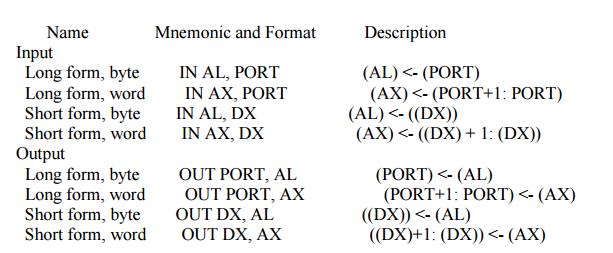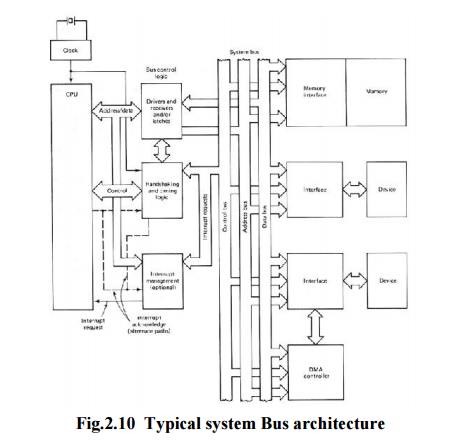IO programming
On the 8086, all programmed communications with the I/O ports is done by the IN and OUT instructions defined in Fig. 6-2.
ü IN and OUT instructions

Note: PORT is a constant ranging from 0 to 255
Flags: No flags are affected
Addressing modes: Operands are limited as indicated above.
If the second operand is DX, then there is only one byte in the instruction and the contents of DX are used as the port address. Unlike memory addressing, the contents of DX are not modified by any segment register. This allows variable access to I/O ports in the range 0 to 64K. The machine language code for the IN instruction is:

Although AL or AX is implied as the first operand in an IN instruction, either AL or AX must be specified so that the assembler can determine the W-bit.
Similar comments apply to the OUT instruction except that for it the port address is the destination and is therefore indicated by the first operand, and the second operand is either AL or AX. Its machine code is:

Note that if the long form of the IN or OUT instruction is used the port address must be in the range 0000 to 00FF, but for the short form it can be any address in the range 0000 to FFFF (i.e. any address in the I/O address space). Neither IN nor OUT affects the flags.
The IN instruction may be used to input data from a data buffer register or the status from a status register. The instructions
IN AX, 28H
MOV DATA_WORD, AX
would move the word in the ports whose address are 0028 and 0029 to the memory location DATA_WORD.
Introduction to Multiprogramming
In order to adapt to as many situations as possible both the 8086 and 8088 have been given two modes of operation, the minimum mode and the maximum mode. The minimum mode is used for a small system with a single processor, a system in which the 8086/8088 generates all the necessary bus control signals directly (thereby minimizing the required bus control logic). The maximum mode is for medium-size to large systems, which often include two or more processors.
System Bus structure

Table 2.6 Pins for read/ write operation

Multiprocessor Systems
Multiprocessor Systems refer to the use of multiple processors that execute instructions simultaneously and communicate using mailboxes and semaphores
Maximum mode of 8086 is designed to implement 3 basic multiprocessor configurations:
1. Coprocessor (8087)
2. Closely coupled (dedicated I/O processor: 8089)
3. Loosely coupled (Multi bus)
Coprocessors and closely coupled configurations are similar - both the CPU and the external processor share:
Memory
I/O system
Bus & bus control logic
Clock generator

